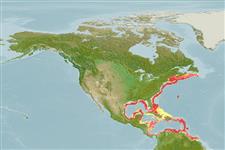Common names from other countries
>
Eupercaria/misc (Various families in series Eupercaria) >
Latilidae (Deepwater tilefishes)
Etymology: Lopholatilus: Greek, lophos = crest + Latin, latus = wide (Ref. 45335).
More on authors: Goode & Bean.
Environment: milieu / climate zone / depth range / distribution range
Ecologia
marinhas demersal; intervalo de profundidade 80 - 540 m (Ref. 5217). Subtropical; 9°C - 14°C (Ref. 33985); 46°N - 5°N, 98°W - 53°W
Western Atlantic: Nova Scotia, Canada south along the U.S., Gulf of Mexico from the Florida Keys, Tampa (Florida) to the Texas/Mexico border, and off Mexico from Tabasco to the Yucatan Peninsula, and along South America from the Gulf of Cariaco (Venezuela) to Suriname (R. Robertson and J. Dooley pers. comm. 2013).
Length at first maturity / Tamanho / Peso / Idade
Maturity: Lm 42.2 range ? - ? cm
Max length : 125 cm TL macho/indeterminado; (Ref. 3276); 95.0 cm FL (female); common length : 90.0 cm TL macho/indeterminado; (Ref. 3276); peso máx. Publicado: 30.0 kg (Ref. 9988); Idade máx. registada: 35 anos (Ref. 6086)
Most common around 200 m, usually over mud or sand bottom and occasionally over rough bottom (Ref. 9988); prefers temperature of 8-17°C (Ref. 5951). Feeds mainly on shrimp and crabs, but also takes fish, squid, bivalves and holothurians. Sensitive to cold water (Ref. 9988), a mass die-off occurred in 1882, after which the species was rare for decades, presumably due to unusually cold water (Ref. 7251). Marketed fresh or frozen; can be steamed, pan-fried, broiled, microwaved and baked (Ref. 9988).
Dooley, J.K., 1978. Branchiostegidae. In W. Fischer (ed.) FAO species identification sheets for fishery purposes. West Atlantic (Fishing Area 31). Volume 1. FAO, Rome. (Ref. 3276)
Categoria na Lista Vermelha da IUCN (Ref. 130435)
CITES (Ref. 128078)
Not Evaluated
Ameaça para o homem
Harmless
Utilização humana
Pescarias: espécies comerciais; peixe desportivo: sim
Mais informação
ColaboradoresFotografiasStamps, Coins Misc.SonsCiguateraVelocidadeTipo de nataçãoÁrea branquialOutras referênciasCérebrosVisão
Ferramentas
Relatórios especiais
Descarregue XML
Fontes da internet
Estimates based on models
Preferred temperature (Ref.
115969): 6.6 - 22.3, mean 16.2 (based on 108 cells).
Phylogenetic diversity index (Ref.
82804): PD
50 = 0.7500 [Uniqueness, from 0.5 = low to 2.0 = high].
Bayesian length-weight: a=0.00776 (0.00407 - 0.01480), b=3.11 (2.93 - 3.29), in cm Total Length, based on LWR estimates for this species & (Sub)family-body (Ref.
93245).
Nível Trófico (Ref.
69278): 3.9 ±0.2 se; based on diet studies.
Resiliência (Ref.
120179): Baixo, tempo mínimo de duplicação da população 4,5 - 14 anos (K=0.09-0.13; tm=5; tmax=35; Fec=195,000).
Fishing Vulnerability (Ref.
59153): High to very high vulnerability (73 of 100).
Climate Vulnerability (Ref.
125649): Moderate vulnerability (38 of 100).
